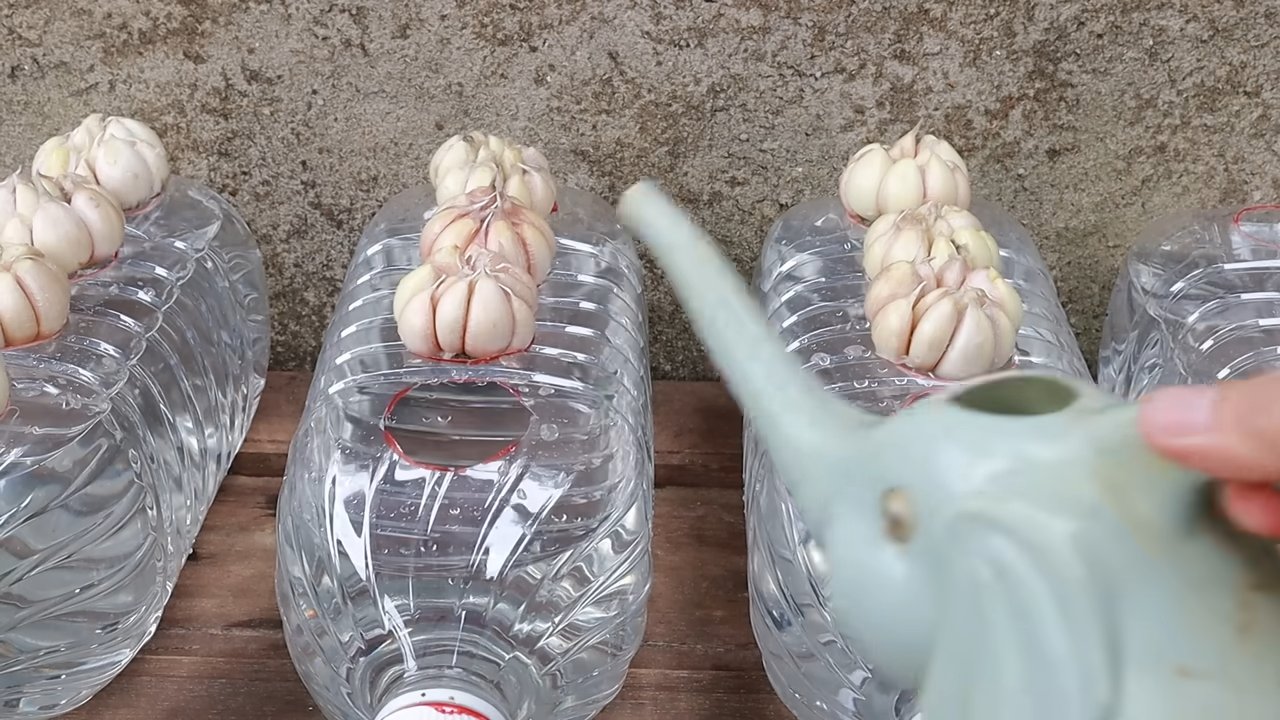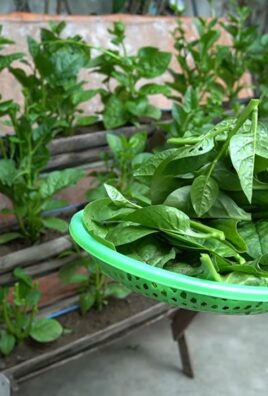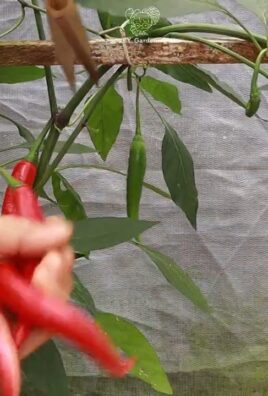Harvest garlic faster? Yes, you read that right! Imagine this: you’re standing in your garden, the sun warm on your face, and instead of spending hours painstakingly digging up each individual garlic bulb, you’re efficiently and quickly gathering your entire harvest. Sounds like a dream, doesn’t it? Well, it doesn’t have to be! This DIY guide is packed with simple, yet effective tricks to help you harvest garlic faster and easier than ever before.
Garlic, a staple in cuisines around the world, has been cultivated for thousands of years. From ancient Egypt, where it was used to fuel the pyramid builders, to its prominent role in Mediterranean cooking, garlic boasts a rich and fascinating history. But let’s be honest, the joy of growing your own garlic can quickly fade when harvest time rolls around. The traditional method of digging each bulb individually can be back-breaking work, especially if you have a large crop.
That’s where these DIY hacks come in! We all lead busy lives, and spending hours on a single gardening task just isn’t feasible for many of us. These tricks are designed to save you time and energy, allowing you to enjoy the fruits (or rather, the bulbs!) of your labor without the aches and pains. So, ditch the tedious digging and get ready to discover how to harvest your garlic crop quickly and efficiently. Let’s get started!

DIY Garlic Harvesting Hack: Say Goodbye to Back Pain!
Okay, garlic lovers, let’s face it: harvesting garlic can be a real pain in the, well, back! Bending over, tugging, sometimes even breaking the precious bulbs… it’s not exactly a fun afternoon activity. But fear not! I’ve discovered a game-changing DIY hack that will make your garlic harvest faster, easier, and way less strenuous. Get ready to say goodbye to backaches and hello to a bountiful garlic crop!
What You’ll Need
Before we dive in, let’s gather our supplies. This hack is surprisingly simple, requiring only a few readily available items:
* A sturdy garden fork (the key to our success!)
* A pair of gardening gloves (protect those hands!)
* A clean, dry space for curing your garlic (a shed, garage, or covered porch works great)
* Twine or string for bundling (optional, but recommended)
* A sharp knife or pruning shears (for trimming roots and stalks)
* A wheelbarrow or garden cart (to transport your harvest)
* A small trowel (for any stubborn bulbs)
The Secret Weapon: The Garden Fork Technique
The traditional method of pulling garlic by hand often results in broken stems and damaged bulbs. The garden fork technique, however, leverages the power of leverage (pun intended!) to gently lift the garlic from the soil, minimizing damage and maximizing your harvest.
Step-by-Step Garlic Harvesting Guide
Alright, let’s get down to business! Here’s how to use the garden fork hack to harvest your garlic like a pro:
1. Timing is Everything: Know When to Harvest. This is crucial! You’ll want to harvest your garlic when the lower leaves start to turn brown and die back, but before the entire plant is completely brown. Usually, this is when about 1/3 to 1/2 of the leaves have browned. If you wait too long, the bulbs can start to separate and the cloves will be less protected. I usually start checking my garlic around late June or early July, depending on the variety and my local climate.
2. Prepare Your Harvesting Area. Before you start digging, make sure you have your curing area ready. This will save you time and prevent your freshly harvested garlic from sitting in the sun. I like to set up a table in my shed with good ventilation. Also, gather your twine, knife, and wheelbarrow so everything is within easy reach.
3. Loosen the Soil (Gently!). This is where the garden fork comes in. Insert the fork into the soil about 4-6 inches away from the garlic plant. Be careful not to pierce the bulb! Gently rock the fork back and forth to loosen the soil around the plant. This will make it much easier to lift the garlic without breaking the stem.
4. Lift, Don’t Pull! Now, carefully lift the garlic plant from the soil using the garden fork. Again, avoid pulling directly on the stem, as this can cause it to snap. The loosened soil should allow the bulb to come up relatively easily. If you encounter any resistance, try loosening the soil a bit more with the fork or using a small trowel to gently dig around the bulb.
5. Handle with Care. Once you’ve lifted the garlic plant, gently shake off any excess soil. Be careful not to bruise or damage the bulb. Place the harvested garlic in your wheelbarrow or garden cart.
6. Repeat, Repeat, Repeat! Continue this process for all your garlic plants, working your way down the row. Remember to be patient and gentle, especially if the soil is compacted or dry.
7. Dealing with Stubborn Bulbs. Sometimes, despite your best efforts, a garlic bulb will refuse to budge. In these cases, use your small trowel to carefully dig around the bulb, loosening the soil from all sides. Then, try lifting it again with the garden fork. If it still won’t come up, you may need to gently pry it out with the trowel.
Curing Your Garlic: The Key to Long-Term Storage
Harvesting is only half the battle! Proper curing is essential for ensuring your garlic stays fresh and flavorful for months to come.
1. Clean (But Don’t Wash!). Gently remove any remaining soil from the garlic bulbs, but avoid washing them with water. Washing can promote mold growth during the curing process. I usually just brush off the dirt with my gloved hands.
2. Trim the Roots. Using your sharp knife or pruning shears, trim the roots of the garlic bulbs to about 1/2 inch. This will help prevent them from rotting.
3. Curing Time. The ideal curing environment is dry, well-ventilated, and out of direct sunlight. A shed, garage, or covered porch works perfectly. You can cure your garlic in a few different ways:
* Braiding: This is a traditional method that looks beautiful and allows for easy storage. Braid the garlic stalks together, starting with three plants and adding more as you go.
* Bundling: If braiding seems too complicated, you can simply bundle the garlic plants together with twine or string. Tie the bundles loosely to allow for good air circulation.
* Laying Flat: You can also cure your garlic by laying it flat on a screen or rack. Just make sure the bulbs are not touching each other to allow for good airflow.
4. Patience is a Virtue. Curing typically takes 2-4 weeks, depending on the humidity and temperature. You’ll know your garlic is cured when the necks are dry and papery, and the outer skins are tight and brittle.
5. Trimming and Storing. Once your garlic is fully cured, trim the stalks to about 1-2 inches above the bulb. Store your cured garlic in a cool, dry, and dark place. A pantry, cellar, or even a paper bag in the refrigerator will work. Avoid storing garlic in plastic bags, as this can trap moisture and promote mold growth.
Extra Tips for a Successful Garlic Harvest
* Water Wisely. Stop watering your garlic about two weeks before harvest. This will help the bulbs dry out and prevent them from rotting.
* Check the Weather. Avoid harvesting garlic on a rainy day. Wet garlic is more susceptible to mold and rot.
* Don’t Be Afraid to Experiment. Every garden is different, so don’t be afraid to experiment with different harvesting techniques to find what works best for you.
* Save the Biggest and Best. Set aside some of your largest and healthiest garlic bulbs for planting next year. This will ensure you have a continuous supply of delicious garlic.
* Enjoy Your Harvest! Now that you’ve harvested and cured your garlic, it’s time to enjoy the fruits (or rather, bulbs!) of your labor. Use it in your favorite recipes, share it with friends and family, and savor the satisfaction of growing your own food.
Troubleshooting Common Garlic Harvesting Problems
* Broken Stems: If you’re breaking a lot of stems, it means you’re either pulling too hard or the soil is too compacted. Try loosening the soil more thoroughly with the garden fork before lifting the garlic.
* Damaged Bulbs: If you’re damaging the bulbs, it means you’re being too rough. Handle the garlic gently and avoid dropping or bruising it.
* Rotting Garlic: If your garlic is rotting during curing, it means the environment is too humid or the garlic wasn’t properly dried. Make sure your curing area is well-ventilated and avoid washing the garlic before curing.
* Small Bulbs: If your garlic bulbs are small, it could be due to a variety of factors, such as poor soil, insufficient watering, or competition from weeds. Make sure your garlic is planted in well-drained soil, watered regularly, and kept free of weeds.
Why This Hack Works So Well
The beauty of this garden fork hack lies in its simplicity and effectiveness. By loosening the soil around the garlic bulb, you reduce the amount of force required to lift it, minimizing the risk of damage. The garden fork also provides a wider base of support than your hands, distributing the pressure more evenly and preventing the stem from snapping. Plus, it saves your back! No more endless bending and tugging.
So there you have it! My foolproof DIY garlic harvesting hack. I hope this helps you enjoy a more bountiful and less painful garlic harvest this year. Happy gardening!

Conclusion
So, there you have it! Mastering the art of harvesting garlic faster isn’t just about saving time; it’s about maximizing your yield, preserving the quality of your precious bulbs, and enjoying the fruits (or rather, the cloves!) of your labor with minimal backache. This DIY trick, focusing on proper timing and strategic digging techniques, is a game-changer for any garlic grower, whether you’re tending a sprawling farm or a humble backyard garden.
Think about it: no more struggling with stubborn bulbs clinging desperately to the soil, no more accidental nicks and bruises that compromise storage life, and no more spending an entire weekend hunched over, aching from head to toe. This method allows you to efficiently and effectively harvest your entire garlic crop, leaving you with more time to enjoy the bounty and plan your next culinary adventure.
But don’t just take our word for it. The real magic happens when you put this technique into practice. Feel free to experiment with slight variations to suit your specific soil type and garlic variety. For instance, if you have particularly heavy clay soil, consider using a garden fork instead of a shovel to gently loosen the soil around the bulbs before pulling. Or, if you’re growing a softneck variety, which tends to bend over more readily, you might find it easier to gently lift the entire plant from the base rather than trying to pull individual bulbs.
Consider these variations:
* For Clay Soil: Use a garden fork to gently loosen the soil around the garlic bulbs before attempting to pull them. This will minimize damage and make the process significantly easier.
* For Softneck Garlic: Instead of pulling individual bulbs, gently lift the entire plant from the base. Softneck varieties tend to bend over, making this method more efficient.
* For Large-Scale Harvesting: If you have a large garlic patch, consider using a tractor-mounted undercutter blade to loosen the soil before hand-harvesting. This will significantly speed up the process.
* Post-Harvest Curing: Remember that proper curing is crucial for long-term storage. Ensure adequate airflow and protection from direct sunlight during the curing process. Consider building a simple curing rack or using a well-ventilated shed.
We’re confident that once you try this DIY trick for harvesting garlic faster, you’ll wonder how you ever did it any other way. It’s a simple, effective, and ultimately rewarding technique that will transform your garlic harvesting experience.
So, grab your tools, head out to your garden, and put this method to the test. And most importantly, don’t forget to share your experiences with us! We’d love to hear your tips, tricks, and any variations you discover along the way. Let’s build a community of garlic-growing enthusiasts who are passionate about maximizing their harvests and enjoying the delicious rewards of their hard work. Share your photos, stories, and insights in the comments section below. Happy harvesting!
Frequently Asked Questions (FAQ)
1. What is the best time to harvest garlic for optimal storage?
The ideal time to harvest garlic is when the lower leaves of the plant begin to turn brown and dry out, while the upper leaves are still mostly green. This usually occurs in mid to late summer, depending on your climate and the garlic variety. Harvesting too early can result in smaller bulbs with less flavor, while harvesting too late can cause the bulbs to split and become more susceptible to disease and spoilage. A good rule of thumb is to harvest when about one-third to one-half of the leaves have turned brown. You can also dig up a test bulb to check its size and maturity. The cloves should be plump and well-defined, with a tight, papery skin.
2. What tools do I need to harvest garlic effectively?
The essential tools for harvesting garlic include a shovel or garden fork, a pair of gloves to protect your hands, and a clean, dry container or basket to collect the harvested bulbs. A sharp knife or pruning shears can also be helpful for trimming the roots and stems after harvesting. For larger-scale operations, a tractor-mounted undercutter blade can significantly speed up the process of loosening the soil.
3. How do I prevent damaging the garlic bulbs during harvesting?
The key to preventing damage during harvesting is to be gentle and avoid pulling directly on the stems. Instead, use a shovel or garden fork to carefully loosen the soil around the bulbs before lifting them out of the ground. If the soil is particularly compacted, you may need to work your way around the bulb gradually, loosening the soil a little at a time. Avoid using excessive force, as this can easily bruise or break the bulbs.
4. What is the proper way to cure garlic after harvesting?
Curing is a crucial step in preserving garlic for long-term storage. After harvesting, gently brush off any excess soil from the bulbs, being careful not to remove the outer skins. Tie the plants together in bundles of 6-10 bulbs and hang them in a well-ventilated, dry, and shaded area. Avoid direct sunlight, as this can cause the bulbs to overheat and spoil. The curing process typically takes 2-4 weeks, depending on the humidity and temperature. The garlic is properly cured when the necks are dry and brittle, and the outer skins are papery and tight.
5. How should I store garlic after it has been cured?
Once the garlic is fully cured, trim the roots to about 1/2 inch and cut the stems to about 1-2 inches above the bulb. Store the cured garlic in a cool, dry, and dark place with good ventilation. Mesh bags or open baskets are ideal for storage. Avoid storing garlic in the refrigerator, as this can cause it to sprout or become moldy. Properly cured and stored garlic can last for several months.
6. Can I eat garlic that has sprouted?
Yes, you can still eat garlic that has sprouted, although the flavor may be slightly milder. Simply remove the green sprout before using the garlic. However, if the garlic is soft, moldy, or has an unpleasant odor, it should be discarded.
7. What are some common problems that can occur during garlic harvesting and curing?
Some common problems include bulb rot, mold growth, and premature sprouting. These problems are often caused by improper harvesting techniques, inadequate curing conditions, or poor storage practices. To prevent these issues, ensure that you harvest at the right time, cure the garlic properly in a well-ventilated area, and store it in a cool, dry, and dark place.
8. How does soil type affect the garlic harvesting process?
Soil type significantly impacts the ease of harvesting. Loose, sandy soil makes harvesting much easier, while heavy clay soil can be more challenging. In clay soil, the bulbs tend to cling more tightly, increasing the risk of damage during harvesting. As mentioned earlier, using a garden fork to loosen the soil before pulling can be particularly helpful in clay soil. Amending the soil with organic matter, such as compost, can also improve drainage and make harvesting easier in the long run.
9. What are the different types of garlic, and how do they affect harvesting?
There are two main types of garlic: hardneck and softneck. Hardneck garlic typically has a stronger flavor and produces a flower stalk (scape), while softneck garlic is milder and does not produce a scape. Hardneck garlic is generally easier to peel and has a shorter storage life than softneck garlic. Softneck garlic is more commonly grown in warmer climates and is often braided for storage. The harvesting process is generally the same for both types, but softneck garlic may be more prone to bending over, requiring you to lift the entire plant from the base rather than pulling individual bulbs.
10. Can I use this method for harvesting other root vegetables?
While this method is specifically tailored for harvesting garlic, the principles of loosening the soil and gently lifting the bulbs can be applied to other root vegetables as well, such as onions, shallots, and potatoes. However, the specific timing and techniques may need to be adjusted depending on the crop. For example, potatoes require a different curing process than garlic. Always research the specific requirements for each vegetable to ensure optimal harvesting and storage.




Leave a Comment